Abstract
Having demonstrated a deficiency in infant cerebral cortex docosahexaenoic acid of formula fed compared with breast milk fed infants, we sought to identify why the extensive subcutaneous tissue triglyceride fatty acid reserves in term new-born infants appeared to be ineffectual in its prevention. In addition to 24 term and six preterm infants who died from 'cot death', tissue was analysed from four perinatal surgical patients and in the former the results were correlated with dietary milk intake. The higher amounts (about 15% by weight) of unsaturated linoleic acid supplied in the formula milks were quantitatively incorporated into the subcutaneous tissue largely at the expense of the saturated palmitic acid possibly compromising adipocyte fluidity. The six preterm infants were in two formula fed groups and there was only one significant difference, namely a higher subcutaneous tissue concentration of alpha-linolenic acid in one of the preterm groups, distinguishing them from their term counterparts. This may imply that the enzymes involved in absorption and digestion of fatty acids are mature in the preterm infant. From birth the mean weight percentage of docosahexaenoic acid (0.4%) fell rapidly to undetectable levels (< 0.05%) in the formula fed group after about two months. It is therefore concluded that if breast feeding is not possible then a minimum daily requirement of 30 mg docosahexaenoic acid (approximately 0.2 g/100 g fatty acids) should be supplied in formulas designed for term infants to prevent the cerebral cortical deficiency of docosahexaenoic acid.
Full text
PDF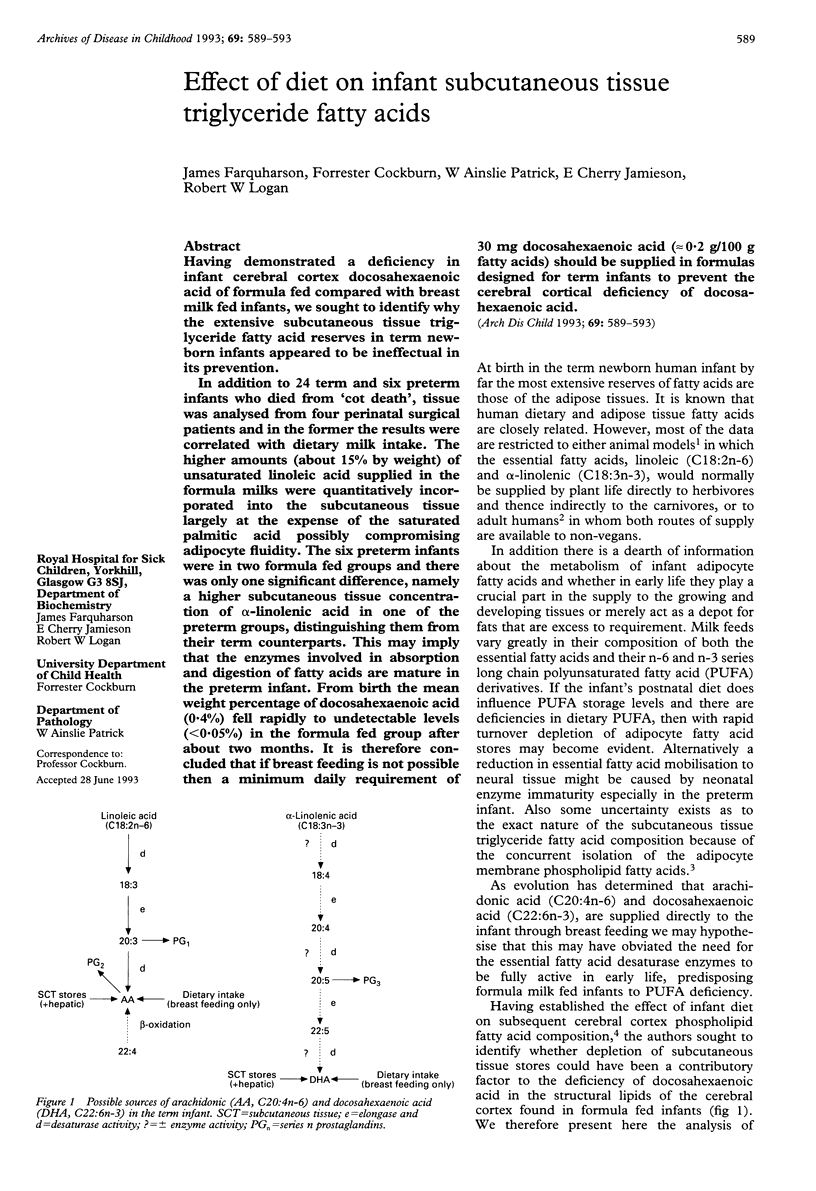
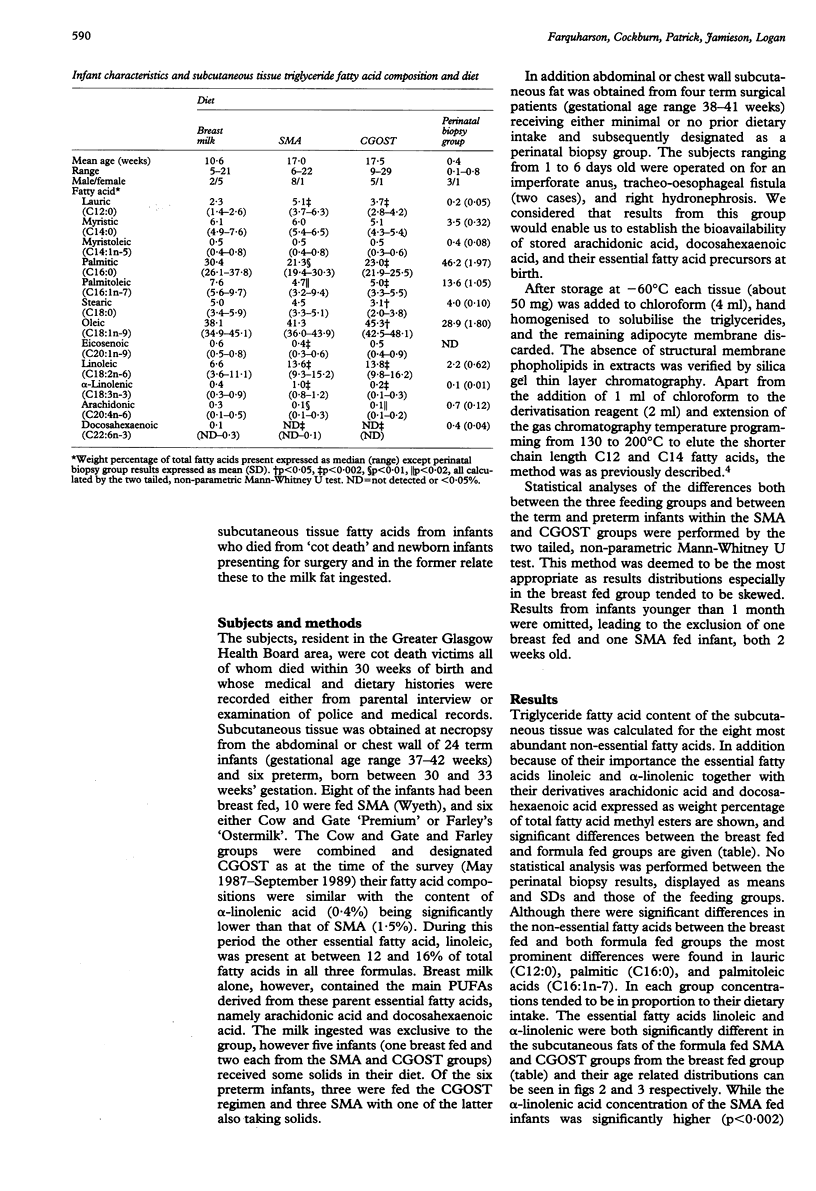
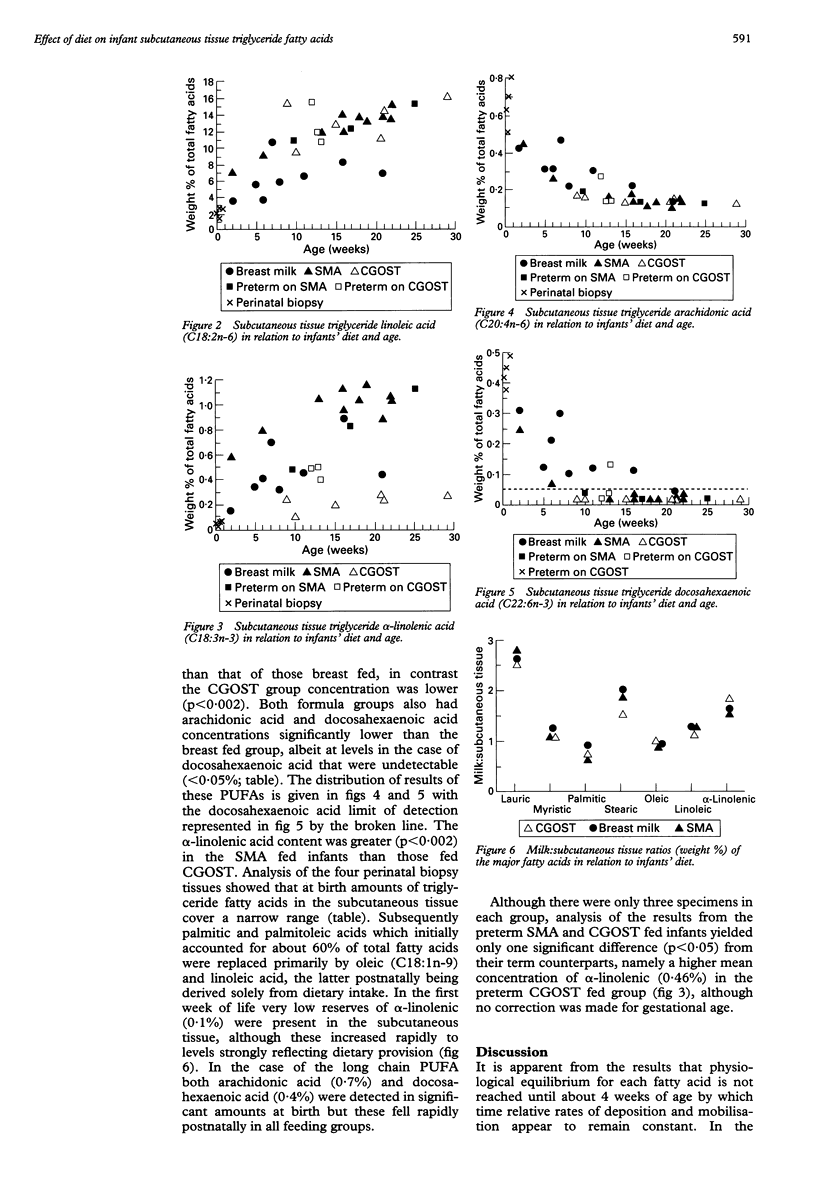
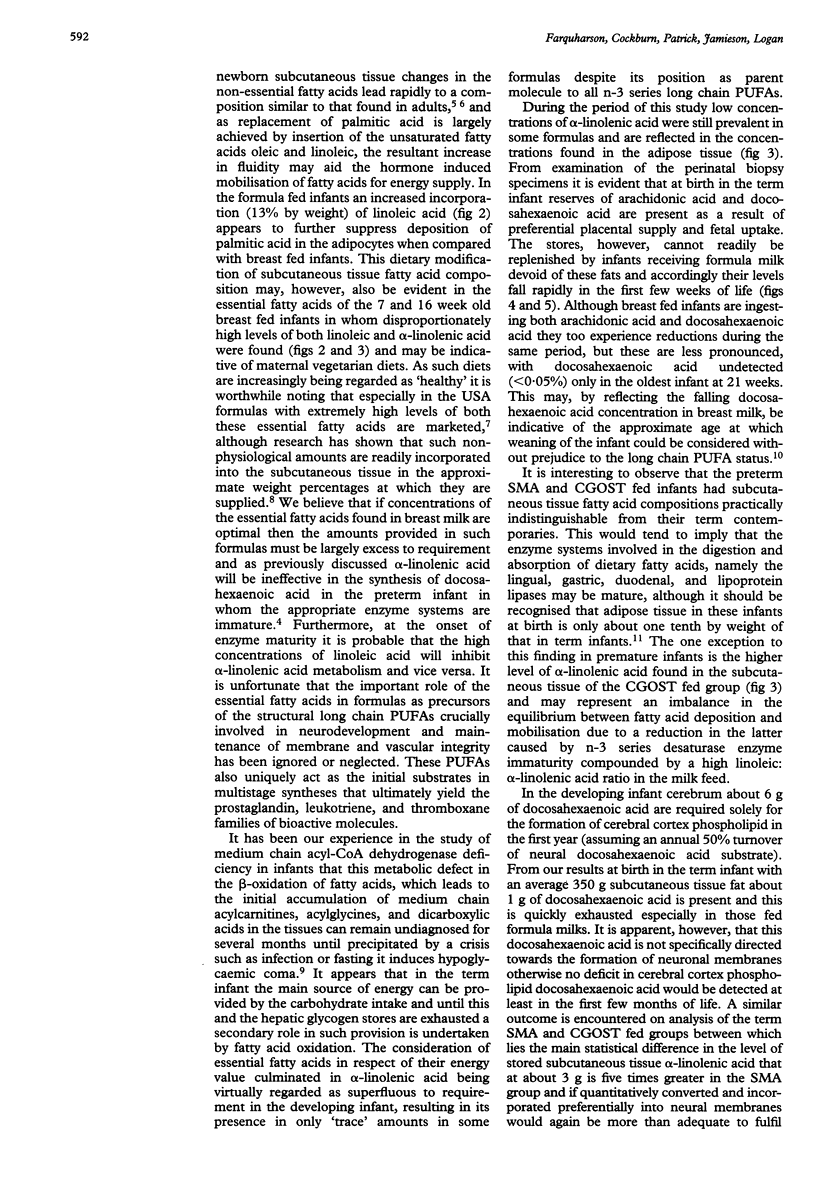
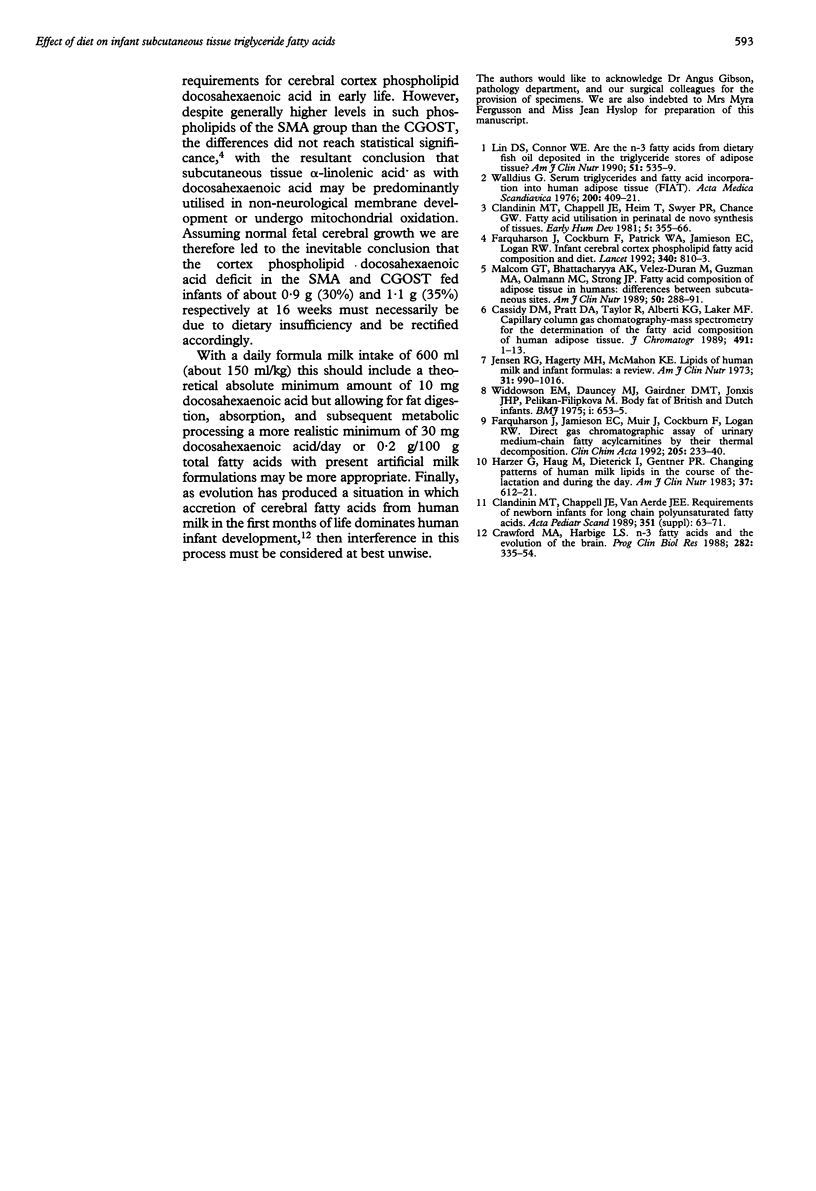
Selected References
These references are in PubMed. This may not be the complete list of references from this article.
- Cassidy D. M., Pratt D. A., Taylor R., Alberti K. G., Laker M. F. Capillary column gas chromatography-mass spectrometry for the determination of the fatty acid composition of human adipose tissue. J Chromatogr. 1989 Jun 30;491(1):1–13. doi: 10.1016/s0378-4347(00)82814-5. [DOI] [PubMed] [Google Scholar]
- Clandinin M. T., Chappell J. E., Heim T., Swyer P. R., Chance G. W. Fatty acid utilization in perinatal de novo synthesis of tissues. Early Hum Dev. 1981 Sep;5(4):355–366. doi: 10.1016/0378-3782(81)90016-5. [DOI] [PubMed] [Google Scholar]
- Clandinin M. T., Chappell J. E., van Aerde J. E. Requirements of newborn infants for long chain polyunsaturated fatty acids. Acta Paediatr Scand Suppl. 1989;351:63–71. doi: 10.1111/j.1651-2227.1989.tb11212.x. [DOI] [PubMed] [Google Scholar]
- Crawford M. A., Harbige L. S. n-3 fatty acids and the evolution of the brain. Prog Clin Biol Res. 1988;282:335–354. [PubMed] [Google Scholar]
- Farquharson J., Cockburn F., Patrick W. A., Jamieson E. C., Logan R. W. Infant cerebral cortex phospholipid fatty-acid composition and diet. Lancet. 1992 Oct 3;340(8823):810–813. doi: 10.1016/0140-6736(92)92684-8. [DOI] [PubMed] [Google Scholar]
- Farquharson J., Jamieson E. C., Muir J., Cockburn F., Logan R. W. Direct gas chromatographic assay of urinary medium-chain fatty acylcarnitines by their thermal decomposition. Clin Chim Acta. 1992 Feb 14;205(3):233–240. doi: 10.1016/0009-8981(92)90064-w. [DOI] [PubMed] [Google Scholar]
- Harzer G., Haug M., Dieterich I., Gentner P. R. Changing patterns of human milk lipids in the course of the lactation and during the day. Am J Clin Nutr. 1983 Apr;37(4):612–621. doi: 10.1093/ajcn/37.4.612. [DOI] [PubMed] [Google Scholar]
- Jensen R. G., Hagerty M. M., McMahon K. E. Lipids of human milk and infant formulas: a review. Am J Clin Nutr. 1978 Jun;31(6):990–1016. doi: 10.1093/ajcn/31.6.990. [DOI] [PubMed] [Google Scholar]
- Lin D. S., Conner W. E. Are the n-3 fatty acids from dietary fish oil deposited in the triglyceride stores of adipose tissue? Am J Clin Nutr. 1990 Apr;51(4):535–539. doi: 10.1093/ajcn/51.4.535. [DOI] [PubMed] [Google Scholar]
- Malcom G. T., Bhattacharyya A. K., Velez-Duran M., Guzman M. A., Oalmann M. C., Strong J. P. Fatty acid composition of adipose tissue in humans: differences between subcutaneous sites. Am J Clin Nutr. 1989 Aug;50(2):288–291. doi: 10.1093/ajcn/50.2.288. [DOI] [PubMed] [Google Scholar]
- Walldius G. Serum triglycerides and fatty acid incorporation into human adipose tissue (TIAT). Their relations with adipose tissue characteristics and glucose tolerance. Acta Med Scand. 1976;200(5):409–421. [PubMed] [Google Scholar]
- Widdowson E. M., Dauncey M. J., Gairdner D. M., Jonxis J. H., Pelikan-Filipkova M. Body fat of British and Dutch infants. Br Med J. 1975 Mar 22;1(5959):653–655. doi: 10.1136/bmj.1.5959.653. [DOI] [PMC free article] [PubMed] [Google Scholar]


